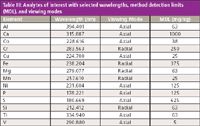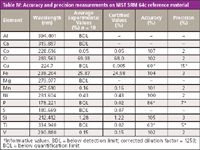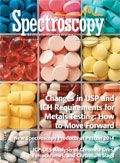Quick and Easy Dissolution of Chromite Ores, Ferrochromes, and Chromium Slags for ICP-OES without Using HF or HClO4
Spectroscopy
A new sodium peroxide fusion method is described, as well as the conditions for inductively coupled plasma–optical emission spectrometry, and a list of the accuracy and precision measurements for all prepared samples.

The traditional method for the dissolution of chromite ore, ferrochrome, and chromium slag samples is time-consuming and requires the use of hydrofluoric (HF) and perchloric (HClO4) acids. A new sodium peroxide fusion method offers a quicker, safer, and more efficient alternative to working with these high-risk acids. Various samples and reference materials were used to validate the new method. This installment of "Atomic Perspectives" describes the fusion method, provides the conditions for inductively coupled plasma–optical emission spectrometry, and lists the accuracy and precision measurements for all prepared samples.
Although there are more than 10 known chromium minerals, only one remains a source of commercial interest. This mineral is known as chromite and has a theoretical composition of FeCr2O4 containing 68% of chromic oxide (Cr2O3), in which the proportions of Mg2+, Fe2+, and Cr3+, Al3+, and Fe3+ may vary considerably (1).
The main product generated by chromite is ferrochrome, a major component in the steel industry (2). In particular, the stainless steel industry uses more than 90% of the world's chromite output. The mining and steel industries must assess the quality of the chromite ore to optimize the grade of their stainless steel product. For this reason, the chemical analysis of the chromite ore as well as its final and waste products are mandatory. Metal analysis traditionally uses atomic absorption (AA) or inductively coupled plasma–optical emission spectrometry (ICP-OES) to measure the metal content in the ores and industrial products. However, the traditional dissolution method for chromite and ferrochrome is a multistep, multiacid digestion that requires the use of hydrofluoric (HF) and perchloric (HClO4) acids and can take 1–3 h (3,4). In the context of a laboratory handling many samples per year, this method would not be very appealing or efficient.
In this installment of "Atomic Perspectives," we present a new peroxide fusion technique that overcomes the problems incurred using the classic approaches for the preparation of chromite ores, ferrochromes, and chromium slags for ICP-OES analyses. This technique yields good analytical results for the broad range of elements found in these samples.
Experimental
Sample Preparation
Peroxide fusions can be performed either manually or with automated systems. Although both methods are efficient, the automated systems have the advantage of increasing productivity, improving safety, maintaining repeatable preparation conditions, and avoiding spattering and cross-contamination. In this project, fusions were performed using a Claisse Peroxide fluxer. The Claisse Peroxide fluxer is a six-position gas fluxer specifically designed to do multiple and repetitive peroxide fusions.
Various samples and reference materials were used to validate the developed method (Table I).

Table I: List of reference materials and samples used to validate the developed method
In a zirconium crucible, 0.2 g of finely ground sample at less than 100 μm was mixed with 0.5 g of sodium carbonate (Na2CO3) and 3.0 g of sodium peroxide (Na2O2). The crucible containing the mixture was placed on the fluxer (4), fused at 560 °C for 3.5 min, and then cooled by the fluxer fans for 4 min.
The cooled zirconium crucible was then placed in a funnel over a 250-mL volumetric flask. Approximately 10 mL of warm (70 °C) ultrafiltered deionized water was added to the crucible followed by 25 mL of HNO3. The dissolution reaction took less than 1 min after which time the crucible was tipped over and rinsed out with deionized ultrafiltered water. Next, 25 mL of HCl was added in the flask, then brought up to volume with diluted acid, and moved to the ICP-OES for analysis.
Instrumentation
The measurements were performed using a PerkinElmer Optima 7300 DV ICP-OES instrument, equipped with WinLab32 for ICP version 4.0 software. On this particular instrument, the ICP torch is mounted in a horizontal orientation in the instrument's shielded torch box, but can be viewed either axially or radially.
A Scott spray chamber with a Gem Tip cross-flow nebulizer was selected as an introduction system because of its proven reliability, robustness, and capability to handle high levels of dissolved solids. The viewing mode is user-selectable on an element-by-element basis. A shear gas flow (compressed air) eliminates the cool plasma tail and allows a direct observation of the plasma's normal analytical zone, thus minimizing chemical matrix effects when the axial-view mode is used.
By combining a sulfur chemiluminescence detector and an echelle optical system, the ICP-OES system can measure all the wavelengths simultaneously. Its wavelength flexibility allows users to easily add new elements or wavelengths as their program changes. The ICP-OES system also includes a 40-MHz free-running solid state radio frequency (rf) generator designed to operate between 750 and 1500 W in 1-W increments. High rf power is required to generate a robust plasma, which is essential for precise analysis of high matrix samples such as fusion samples (5). Refer to Table II for detailed ICP-OES operating parameters.

Table II: ICP-OES instrument operating parameters
Results and Discussion
The following criteria were taken into consideration in selecting the wavelength: the freedom from spectral interferences and the different sensitivities and expected concentration in the samples. The most sensitive line was not always used to avoid spectral interferences and to remain in the linear range. Observed interferences were compensated for by modifying the processing parameters (for example, adjusting the background correction points, applying multicomponent spectral fittings [MSF] or interelemental corrections [IEC]).

Table III: Analytes of interest with selected wavelengths, method detection limits (MDL), and viewing modes
Method detection limits (MDLs) were based on 10 replicate measurements of a series of low concentration or diluted sample solutions. The MDL was calculated by multiplying the standard deviation of the 10 replicate measurements by 3 (6):

where S10 is the standard deviation of the 10 replicates and CDF is the corrected dilution factor.

Table IV: Accuracy and precision measurements on NIST SRM 64c reference material
The accuracy and precision of the method was evaluated. The accuracy was determined by calculating the elemental recovery of certified reference materials (CRMs). The precision was determined by preparing and measuring 10 replicates of the various CRMs. The results for each CRM are presented in Tables IV, V, and VI. The accuracy and precision obtained demonstrates that the developed method performed very well.

Table V: Accuracy and precision measurements on Mintek SARM 8 reference material
Prefusion spikes were performed on samples and CRMs (Table VII) to monitor the elemental recoveries and further validate the method.

Table VI: Accuracy and precision measurements on Mintek SARM77 reference material
Conclusion
Conventional or microwave-assisted acid digestion techniques are commonly used for the dissolution of chromite ores, ferrochromes, and chromium slags for ICP-OES analysis. However, besides being laborious and time-consuming, they do not provide total dissolution of the samples.

Table VII: Recovery results on prefusion spikes (n = 5)*
The peroxide fusion technique has shown to be a viable alternative. The analytical method described here results in clear solutions free of solid residues and allows users to get rid of hazardous materials. Using a simultaneous ICP-OES method, metal components are measured at low and high concentrations in a variety of samples and reference materials, demonstrating good precision and accuracy. Finally, this new sample preparation method is quick, cost-effective, and easy to implement, especially in production laboratories.
References
(1) J.F. Papp, "Mineral Commodity Summary 2006: Chromium," United States Geological Survey. http://minerals.usgs.gov/minerals/pubs/commodity/chromium/chrommcs06.pdf.
(2) M. Vaamonde, R.M. Alonso, J. García, and J. Izaga, At. Spectrom. 3, 1101–1103 (1988).
(3) D.C. Smith, J.R. Johnson, and G.C. Soth, Applied Spectroscopy 24(6), 576–579 (1970).
(4) http://www.claisse.com/fusion-instrument-peroxide-fluxer.php, Corporation Scientifique Claisse Inc.
(5) P. Sarojam, "Trace Metal Characterization of Soils Using the Optima 7300DV ICP-OES," PerkinElmer Inc., Application Note.
(6) Protocole pour la validation d'une méthode d'analyse en chimie, Centre d'Expertise en Analyse Environnementale du Québec, Ministère de l'Environnement, Document de référence DR-12-VMC, Édition courante, 21 pages.
Mélanie Bédard, MSc, Chimiste, is an ICP-OES applications specialist with Corporation Scientifique Claisse in Quebec, Canada. Direct correspondence to: mbedard@claisse.com

Mélanie Bédard, MSc
Janice Pitre, MSc, Chimiste, is a technical representative with Corporation Scientifique Claisse.

Janice Pitre, MSc

High-Speed Laser MS for Precise, Prep-Free Environmental Particle Tracking
April 21st 2025Scientists at Oak Ridge National Laboratory have demonstrated that a fast, laser-based mass spectrometry method—LA-ICP-TOF-MS—can accurately detect and identify airborne environmental particles, including toxic metal particles like ruthenium, without the need for complex sample preparation. The work offers a breakthrough in rapid, high-resolution analysis of environmental pollutants.
Applications of Micro X-Ray Fluorescence Spectroscopy in Food and Agricultural Products
January 25th 2025In recent years, advances in X-ray optics and detectors have enabled the commercialization of laboratory μXRF spectrometers with spot sizes of ~3 to 30 μm that are suitable for routine imaging of element localization, which was previously only available with scanning electron microscopy (SEM-EDS). This new technique opens a variety of new μXRF applications in the food and agricultural sciences, which have the potential to provide researchers with valuable data that can enhance food safety, improve product consistency, and refine our understanding of the mechanisms of elemental uptake and homeostasis in agricultural crops. This month’s column takes a more detailed look at some of those application areas.
Trending on Spectroscopy: The Top Content of 2024
December 30th 2024In 2024, we launched multiple content series, covered major conferences, presented two awards, and continued our monthly Analytically Speaking episodes. Below, you'll find a selection of the most popular content from Spectroscopy over the past year.